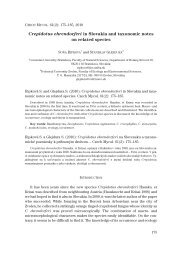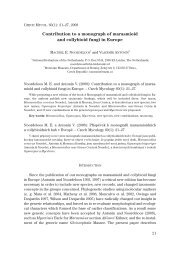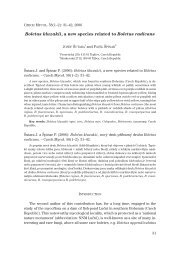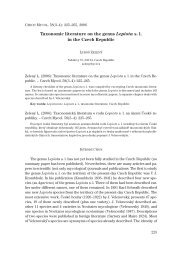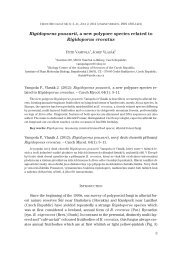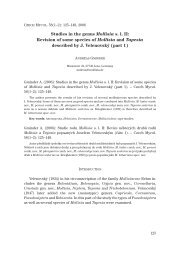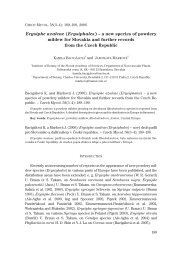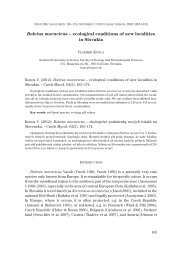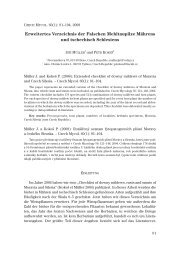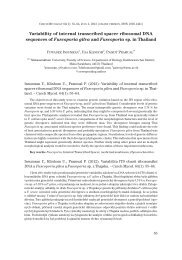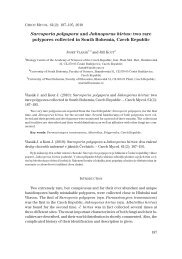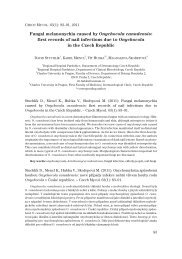Evaluation of the pathogenicity of selected nematophagous fungi
Evaluation of the pathogenicity of selected nematophagous fungi
Evaluation of the pathogenicity of selected nematophagous fungi
Create successful ePaper yourself
Turn your PDF publications into a flip-book with our unique Google optimized e-Paper software.
CZECH MYCOL. 61(2): 139–147, 2010<br />
<strong>Evaluation</strong> <strong>of</strong> <strong>the</strong> <strong>pathogenicity</strong> <strong>of</strong> <strong>selected</strong> <strong>nematophagous</strong><br />
<strong>fungi</strong><br />
MILOSLAV ZOUHAR 1* , ONDŘEJ DOUDA 2 , DAVID NOVOTNÝ 2 , JANA NOVÁKOVÁ 1<br />
and JANA MAZÁKOVÁ 1<br />
1 Czech University <strong>of</strong> Life Sciences, Faculty <strong>of</strong> Agrobiology, Food and Natural Resources, Department<br />
<strong>of</strong> Plant Protection, Kamýcká 129, 165 21 Praha 6 – Suchdol, Czech Republic, *corresponding author,<br />
zouhar@af.czu.cz<br />
2 Research Institute <strong>of</strong> Crop Production, Division <strong>of</strong> Plant Medicine, Drnovská 507,<br />
161 06 Praha 6 – Ruzyně, Czech Republic<br />
Zouhar M., Douda O., Novotný D., Nováková J. and Mazáková J. (2010): <strong>Evaluation</strong><br />
<strong>of</strong> <strong>the</strong> <strong>pathogenicity</strong> <strong>of</strong> <strong>selected</strong> <strong>nematophagous</strong> <strong>fungi</strong> – Czech Mycol. 61(2):<br />
139–147.<br />
The virulence <strong>of</strong> <strong>selected</strong> strains <strong>of</strong> six <strong>nematophagous</strong> <strong>fungi</strong> on three species <strong>of</strong> phytopathogenic<br />
nematodes was evaluated, whereby differences in <strong>pathogenicity</strong> between <strong>the</strong> investigated fungal taxa<br />
were found. Arthrobotrys oligospora was <strong>the</strong> most pathogenic fungus to all three tested species <strong>of</strong><br />
nematodes.<br />
Key words: <strong>nematophagous</strong> <strong>fungi</strong>, nematodes, <strong>pathogenicity</strong>, Arthrobotrys, Dactylellina, Dactylella,<br />
Pochonia, Ditylenchus dipsaci, Globodera rostochiensis, Meloidogyne hapla.<br />
Zouhar M., Douda O., Novotný D., Nováková J. a Mazáková J. (2010): Zhodnocení<br />
patogenity vybraných druhů nemat<strong>of</strong>ágních hub. – Czech Mycol. 61(2): 139–147.<br />
Byla hodnocena virulence vybraných kmenů šesti druhů nemat<strong>of</strong>ágních hub na tři druhy fytopatogenních<br />
háďátek. Byly zjištěny rozdíly v patogenitě mezi zkoumanými druhy hub. Druh Arthrobotrys<br />
oligospora byl nejvíce patogenní ze všech testovaných hub a to ke všem druhům háďátek.<br />
INTRODUCTION<br />
Nematophagous <strong>fungi</strong> are an interesting ecological group <strong>of</strong> <strong>fungi</strong> because<br />
<strong>the</strong>y can be used to control phytoparasitic nematodes. Species <strong>of</strong> <strong>nematophagous</strong><br />
<strong>fungi</strong> belong to many taxonomic groups. According to <strong>the</strong> type <strong>of</strong> pathogenesis in<br />
nematodes, <strong>nematophagous</strong> <strong>fungi</strong> are usually divided into endoparasites and<br />
predators (Barron 2004). So far little attention has been paid to <strong>the</strong> occurrence <strong>of</strong><br />
<strong>nematophagous</strong> <strong>fungi</strong> in <strong>the</strong> Czech Republic (Rozsypal 1934, Ipserová 1982,<br />
Novotná 1989, Kubátová et al. 2000).<br />
The species from <strong>the</strong> Arthrobotrys – Dactylaria – Monacrosporium genera<br />
complex are predators and create organs <strong>of</strong> capture (adhesive knobs or nets, con-<br />
139
CZECH MYCOL. 61(2): 139–147, 2010<br />
stricting and non-constricting rings). These <strong>fungi</strong> belong to <strong>the</strong> Orbiliales order<br />
(Ascomycota) and most <strong>of</strong> <strong>the</strong>m are anamorphic stages <strong>of</strong> Orbilia (Rubner 1996,<br />
Barron 2004, Li et al. 2005, Kirk et al. 2008).<br />
The endoparasites produce infective conidia or zoospores that adhere and attack<br />
<strong>the</strong> nematode. E.g. Esteya vermicola and species <strong>of</strong> <strong>the</strong> genus Pochonia belong<br />
to this group (Kubátová et al. 2000, Barron 2004). Fungi <strong>of</strong> <strong>the</strong> genus<br />
Pochonia are close to Verticillium and belong to <strong>the</strong> Hypocreales order<br />
(Ascomycota) (Zare et al. 2001, Kirk et al. 2008).<br />
Nematodes are very destructive organisms in agriculture and cause huge crop<br />
losses worldwide (Oka et al. 2000). The economically most important nematodes<br />
in Central Europe, including <strong>the</strong> Czech Republic, are Ditylenchus dipsaci,<br />
Globodera rostochiensis and Meloidogyne hapla. D. dipsaci (Stem and Bulb Nematode)<br />
is a significant pest <strong>of</strong> garlic and onion and is a quarantine organism in<br />
many countries <strong>of</strong> Europe. M. hapla (Nor<strong>the</strong>rn Root Knot Nematode) poses especially<br />
threat to cultures <strong>of</strong> root vegetables. The quarantine species G. rostochiensis<br />
(Potato Cyst Nematode) causes serious losses in potato production.<br />
Phytopathogenic nematodes are difficult to control and methods to biologically<br />
control <strong>the</strong>m are searched for (Brodie 1984, Janson and Lopez-Llorca 2004).<br />
Knowledge <strong>of</strong> <strong>the</strong> <strong>pathogenicity</strong> <strong>of</strong> <strong>nematophagous</strong> <strong>fungi</strong> to nematodes is important<br />
for effective utilization <strong>of</strong> <strong>the</strong>se <strong>fungi</strong> as nematode control agents.<br />
Arthrobotrys species, especially A. oligospora, have been investigated most frequently<br />
in this respect (Timper and Brodie 1993, Belder and Jansen 1994, Galper<br />
et al. 1995, Kumar and Singh 2006). The first step to recognise virulent strains is an<br />
in vitro <strong>pathogenicity</strong> test (culture <strong>of</strong> <strong>nematophagous</strong> <strong>fungi</strong> and nematode). The<br />
next step is to investigate <strong>the</strong> involved living plants (Belder and Jansen 1994,<br />
Galper et al. 1995, Kumar and Singh 2006).<br />
The objective <strong>of</strong> this work was to evaluate <strong>the</strong> virulence <strong>of</strong> <strong>selected</strong> strains <strong>of</strong><br />
fungal species to <strong>the</strong> three phytopathogenic nematode species mentioned above.<br />
MATERIALS AND METHODS<br />
In <strong>the</strong> study, six strains <strong>of</strong> nematopathogenic <strong>fungi</strong> were used. Arthrobotrys<br />
oligospora Fresen. 1850 (strain CBS 115.81), Dactylella oviparasitica G. R. Stirling<br />
et Mankau 1978 (strain CBS 347.85), Dactylellina candida (Nees) Yan Li 2006<br />
(strain CBS 546.63), Dactylellina lysipaga (Drechsler) M. Scholler, Hagedorn et<br />
A. Rubner 1999 (strain CBS 581.91), Dactylellina phymatopaga (Drechsler) Y. Li<br />
2005 (strain CBS 450.93), and Pochonia chlamydosporia var. chlamydosporia<br />
(Goddard) Zare et W. Gams (strain CBS 113566) were obtained from <strong>the</strong><br />
Centraalbureau voor Schimmelcultures.<br />
140
ZOUHAR M. ET AL.: EVALUATION OF THE PATHOGENICITY OF SELECTED NEMATOPHAGOUS FUNGI<br />
Pathogenicity <strong>of</strong> <strong>the</strong> mentioned fungal species to <strong>the</strong> three species <strong>of</strong> nematodes<br />
was evaluated. The Ditylenchus dipsaci nematodes were extracted from infested<br />
plants <strong>of</strong> endive (Cichorium endivia). This population originated from<br />
Slovenia and was naturally reproduced in <strong>the</strong> Czech Republic several times.<br />
Globodera rostochiensis (Ro1 pathotype) was obtained from <strong>the</strong> Field Research<br />
Station <strong>of</strong> <strong>the</strong> Potato Research Institute Ltd. (Kunratice, near <strong>the</strong> town <strong>of</strong> Šluknov,<br />
North Bohemia, Czech Republic) and multiplied by <strong>the</strong> authors. The population <strong>of</strong><br />
Meloidogyne hapla was acquired from a carrot field in <strong>the</strong> vicinity <strong>of</strong> <strong>the</strong> town <strong>of</strong><br />
Lysá nad Labem (town district <strong>of</strong> Litol), Central Bohemia, Czech Republic.<br />
The authors used original methods in <strong>the</strong> study. The upper parts (lids) <strong>of</strong> small<br />
sterile Petri dishes were inserted in large sterile Petri dishes containing sterile filter<br />
paper. The filter paper was moistened with sterile distilled water. Microscope<br />
slides with a culture <strong>of</strong> <strong>the</strong> <strong>nematophagous</strong> fungus on agar medium were placed<br />
on <strong>the</strong> smaller Petri dishes. In <strong>the</strong> experiments, rose bengal agar (dextrose – 10 g,<br />
KH 2<br />
PO 4<br />
– 1 g, peptone from soy –5g,rose bengal – 0.05 g, MgSO 4<br />
– 0.5 g, agar –<br />
15 g, distilled water – 1000 ml, autoclaved for 15 min. at 120 °C) was used. An agar<br />
droplet was placed on a microscope slide, inoculated with <strong>the</strong> <strong>nematophagous</strong><br />
fungus and covered with a sterile cover glass slip. The Petri dishes were wrapped<br />
in Parafilm and cultivated for 3 days at 22 °C.<br />
After 3 days, 50 μl <strong>of</strong> <strong>the</strong> aquatic suspension containing one <strong>of</strong> <strong>the</strong> three nematode<br />
species researched was pipetted under <strong>the</strong> edge <strong>of</strong> <strong>the</strong> cover glass slip. The<br />
concentration <strong>of</strong> <strong>the</strong> nematode suspension was 1.66 × 10 3 specimens/ml in <strong>the</strong><br />
case <strong>of</strong> Meloidogyne hapla; 2.46 × 10 3 /ml and 0.32 × 10 3 /ml in Globodera<br />
rostochiensis and Ditylenchus dipsaci, respectively. The number <strong>of</strong> inserted<br />
nematodes was determined under a stereomicroscope. In <strong>the</strong> control, nematodes<br />
were applied on <strong>the</strong> medium without <strong>nematophagous</strong> <strong>fungi</strong>. The slides were cultivated<br />
ano<strong>the</strong>r 3 days under <strong>the</strong> same conditions, after which evaluation was performed.<br />
Ten replicates (microscopic slides) were used for each fungus and nematode<br />
species.<br />
The total number <strong>of</strong> nematodes and specimens affected by particular<br />
<strong>nematophagous</strong> <strong>fungi</strong> was assessed under 20× and 40× magnifications, respectively.<br />
The obtained data were calculated as mortality percentage and arcsin root<br />
square transformed. A final analysis was performed by single factor ANOVA followed<br />
by Tukey’s test (Statistica 8).<br />
RESULTS AND DISCUSSION<br />
No mortality was observed in <strong>the</strong> control variants, in which nematodes were<br />
cultivated on pure medium. This indicates that <strong>the</strong> screening method was appropriate.<br />
141
CZECH MYCOL. 61(2): 139–147, 2010<br />
Tab. 1. Comparison <strong>of</strong> <strong>the</strong> mortality <strong>of</strong> <strong>the</strong> investigated nematodes caused by <strong>nematophagous</strong> <strong>fungi</strong> in<br />
experimental variants and untreated control. P-values <strong>of</strong> Tukey’s test; variants with <strong>the</strong> same number<br />
are not significantly different at P ≤ 0.05.<br />
Nematode species<br />
Fungus species Ditylenchus dipsaci Globodera rostochiensis Meloidogyne hapla<br />
Dactylellina phymatopaga 0.929637095991 a 0.0001308976486 d 0.000138166713 bc<br />
Arthrobotrys oligospora 0.000130897649 b 0.0001308976485 c 0.000138166579 c<br />
Dactylella oviparasitica 0.000165274330 c 0.0001309068053 d 0.000154478031 b<br />
Dactylellina lysipaga 0.999955673983 a 0.0001308976485 b 0.000138166578 bc<br />
Dactylellina candida 0.000130906649 c 0.8598005409330 a *<br />
Pochonia chlamydosporia 0.976671654438 a 0.0001309415876 d 0.000154202149 c<br />
Control a a a<br />
*–not assessed; cultivation <strong>of</strong> <strong>the</strong> fungus failed<br />
Ditylenchus dipsaci<br />
100<br />
80<br />
Mortality [%]<br />
60<br />
40<br />
20<br />
0<br />
Dactylellina phymatopaga<br />
Arthrobotrys oligospora<br />
Dactylella oviparasitica<br />
Dactylellina lysipaga<br />
Dactylellina candida<br />
Fungus species<br />
Pochonia chlamydosporia<br />
Control<br />
Average<br />
±SD<br />
Fig. 1. Average mortality <strong>of</strong> <strong>the</strong> nematode Ditylenchus dipsaci caused by <strong>nematophagous</strong> <strong>fungi</strong> in experimental<br />
variants after three days <strong>of</strong> incubation.<br />
142
ZOUHAR M. ET AL.: EVALUATION OF THE PATHOGENICITY OF SELECTED NEMATOPHAGOUS FUNGI<br />
Globodera rostochiensis<br />
100<br />
80<br />
Mortality [%]<br />
60<br />
40<br />
20<br />
0<br />
Dactylellina phymatopaga<br />
Arthrobotrys oligospora<br />
Dactylella oviparasitica<br />
Dactylellina lysipaga<br />
Dactylellina candida<br />
Fungus species<br />
Pochonia chlamydosporia<br />
Control<br />
Average<br />
±SD<br />
Fig. 2. Average mortality <strong>of</strong> <strong>the</strong> nematode Globodera rostochiensis caused by <strong>nematophagous</strong> <strong>fungi</strong> in<br />
experimental variants after three days <strong>of</strong> incubation.<br />
Meloidogyne hapla<br />
100<br />
80<br />
Mortality [%]<br />
60<br />
40<br />
20<br />
0<br />
Dactylellina phymatopaga<br />
Arthrobotrys oligospora<br />
Dactylella oviparasitica<br />
Dactylellina lysipaga<br />
Fungus species<br />
Pochonia chlamydosporia<br />
Control<br />
Average<br />
±SD<br />
Fig. 3. Average mortality <strong>of</strong> <strong>the</strong> nematode Meloidogyne hapla caused by <strong>nematophagous</strong> <strong>fungi</strong> in experimental<br />
variants after three days <strong>of</strong> incubation.<br />
143
CZECH MYCOL. 61(2): 139–147, 2010<br />
Within <strong>the</strong> Ditylenchus dipsaci variants, statistically significant differences<br />
were discovered in <strong>the</strong> cases <strong>of</strong> Arthrobotrys oligospora, Dactylella oviparasitica<br />
and Arthrobotrys candida. A. oligospora was <strong>the</strong> most effective in D. dipsaci<br />
trapping (average mortality 97 %) while A. candida and D. oviparasitica were<br />
much less effective (average mortality 54 % and 40 %) (Fig. 1, Tab. 1).<br />
Globodera rostochiensis was suppressed with Dactylellina phymatopaga,<br />
Arthrobotrys oligospora, Dactylella oviparasitica, Dactylellina lysipaga and<br />
Pochonia chlamydosporia species. A. oligospora was <strong>the</strong> most effective, because<br />
no living nematodes (average mortality 100 %) were found in this variant. High<br />
mortality was recorded in G. rostochiensis in <strong>the</strong> experiment with D. lysipaga<br />
(average mortality 86 %). The mortality caused by D. phymatopaga, D. oviparasitica<br />
and P. chlamydosporia was significantly lower (34, 21, and 20 %, respectively)<br />
(Fig. 2, Tab. 1).<br />
In <strong>the</strong> case <strong>of</strong> <strong>the</strong> nematode Meloidogyne hapla, all tested <strong>fungi</strong> were effective.<br />
A. oligospora was again <strong>the</strong> most efficient; <strong>the</strong> average mortality was close to<br />
80 %. However, a nearly identical result was found in <strong>the</strong> experiment with D. lysipaga<br />
(average mortality 79 %). The mortality caused by D. phymatopaga (66 %),<br />
D. oviparasitica (41 %) and P. chlamydosporia (39 %) was significantly lower<br />
(Fig. 3, Tab. 1). D. candida was not tested since <strong>the</strong> cultivation failed.<br />
The <strong>pathogenicity</strong> <strong>of</strong> <strong>nematophagous</strong> <strong>fungi</strong> under in vitro conditions was investigated<br />
on a limited number <strong>of</strong> nematodes species. Using this approach, phytopathogenic<br />
(Timper and Brodie 1993, Belder and Jansen 1994, Galper et al. 1995,<br />
Jacobs 1997, Kumar and Singh 2006), free living (Galper et al. 1995; Gomes et al.<br />
1999, 2001) and gastrointestinal parasitic (Gomes et al. 1999, 2001) nematodes<br />
were investigated. The <strong>pathogenicity</strong> <strong>of</strong> <strong>nematophagous</strong> <strong>fungi</strong> on Meloidogyne<br />
hapla and Globodera rostochiensis under in vitro conditions had been only investigated<br />
by Belder and Jansen (1994). In her study <strong>of</strong> <strong>fungi</strong> associated with cysts <strong>of</strong><br />
G. rostochiensis, Novotná (1989) did not record any <strong>nematophagous</strong> <strong>fungi</strong> and<br />
<strong>the</strong>refore did not investigate <strong>the</strong> <strong>pathogenicity</strong> <strong>of</strong> <strong>nematophagous</strong> <strong>fungi</strong> on this<br />
nematode species. Before our study, nobody had studied <strong>the</strong> <strong>pathogenicity</strong> <strong>of</strong><br />
<strong>nematophagous</strong> <strong>fungi</strong> on Ditylenchus dipsaci under in vitro conditions.<br />
Only a few <strong>nematophagous</strong> fungal species have been studied for <strong>pathogenicity</strong><br />
in vitro. A. oligospora is <strong>the</strong> most frequently investigated taxon (Timper and Brodie<br />
1993, Belder and Jansen 1994, Galper et al. 1995, Gomes et al. 2001). P. chlamydosporia<br />
is frequently studied as well, but as a pathogen <strong>of</strong> nematode eggs only<br />
(Braga et al. 2008, Singh and Mathur 2010). D. candida, Monacrosporium spp.,<br />
Nematoctonus sp. and various Arthrobotrys species have been examined much less<br />
frequently (Timper and Brodie 1993, Galper et al. 1995, Jacobs 1997, Gomes et al.<br />
1999, 2001, Kumar and Singh 2006). Nobody had investigated <strong>the</strong> <strong>pathogenicity</strong> <strong>of</strong><br />
D. oviparasitica, D. lysipaga and D. phymatopaga before our study.<br />
144
ZOUHAR M. ET AL.: EVALUATION OF THE PATHOGENICITY OF SELECTED NEMATOPHAGOUS FUNGI<br />
In <strong>the</strong> present study, A. oligospora was <strong>the</strong> most pathogenic to all nematode<br />
species tested. It caused mortalities <strong>of</strong> 97 %, 100 % and 80 % in D. dipsaci, G. rostochiensis<br />
and M. hapla, respectively. This fungal species thus appears to be very<br />
pathogenic to various nematode species. Similar results were obtained by Timper<br />
and Brodie (1993), Belder and Jansen (1994), and Galper et al. (1995). Belder and<br />
Jansen (1994), who observed high <strong>pathogenicity</strong> <strong>of</strong> A. oligospora to M. hapla,<br />
M. incognita, and Pratylenchus penetrans, found a lower <strong>pathogenicity</strong> to<br />
G. rostochiensis (mortality approx. 20 %) than according to our results (mortality<br />
100 %). Various strains were investigated in <strong>the</strong>se studies and <strong>the</strong> virulence <strong>of</strong><br />
each strain to G. rostochiensis turned out to be different.<br />
Many strains <strong>of</strong> pathogenic <strong>fungi</strong> which are kept under in vivo conditions for<br />
many years show lower virulence than those newly obtained from natural substrates.<br />
The virulence observed in <strong>the</strong> present study could have been influenced<br />
by this factor, because <strong>the</strong> used strains were isolated at different times, <strong>the</strong> first<br />
one in 1963. Age could be <strong>the</strong> reason <strong>of</strong> <strong>the</strong> lower virulence <strong>of</strong> <strong>the</strong> D. candida<br />
strain, which was <strong>the</strong> oldest one. The second oldest was <strong>the</strong> A. oligospora strain,<br />
which was <strong>the</strong> most pathogenic species and this strain could have been more virulent<br />
if it had been obtained more recently. Age influences <strong>the</strong> virulence <strong>of</strong> <strong>the</strong><br />
strains, but <strong>the</strong> <strong>pathogenicity</strong> <strong>of</strong> each species is determined by way <strong>the</strong> nematodes<br />
are trapped, and cannot be influenced by time.<br />
Timper and Brodie (1993), Belder and Jansen (1994), Galper et al. (1995),<br />
Kumar and Singh (2006), and Gomes et al. (1999, 2001) used a slightly different<br />
way <strong>of</strong> evaluating <strong>the</strong> <strong>pathogenicity</strong> <strong>of</strong> <strong>nematophagous</strong> <strong>fungi</strong> in vitro, namely on<br />
agar medium in small Petri dishes. In <strong>the</strong> present study, <strong>the</strong> <strong>pathogenicity</strong> was<br />
studied on agar medium on a microscopic slide. We found <strong>the</strong> same results as<br />
were obtained by Timper and Brodie (1993), Belder and Jansen (1994), and Galper<br />
et al. (1995), who used a slightly different method.<br />
D. candida seems to be less pathogenic to nematodes when compared with<br />
A. oligospora (Belder and Jansen 1994, Galper et al. 1995) and A. superba (Jacobs<br />
1997). Our results are similar. In <strong>the</strong> present study, this species caused a mortality<br />
<strong>of</strong> more than 50 % in Ditylenchus dipsaci, but no statistically significant mortality in<br />
Globodera rostochiensis was recorded (<strong>the</strong> mortality <strong>of</strong> M. hapla was not evaluated.)<br />
A. oligospora, which was <strong>the</strong> most pathogenic fungus, will be used for our in<br />
vivo experiments in an application with <strong>nematophagous</strong> <strong>fungi</strong> suppressing <strong>the</strong><br />
three phytopathogenic nematodes.<br />
ACKNOWLEDGEMENTS<br />
This work was supported by <strong>the</strong> Ministry <strong>of</strong> Agriculture <strong>of</strong> <strong>the</strong> Czech Republic,<br />
project no. QH81163, and <strong>the</strong> Ministry <strong>of</strong> Education, Youth and Sports <strong>of</strong> <strong>the</strong><br />
145
CZECH MYCOL. 61(2): 139–147, 2010<br />
Czech Republic, project no. MSM6046070901. The authors are grateful to Mr. Jan<br />
Urban for helping with processing <strong>the</strong> samples and to Dr. Gregor Urek and Mrs.<br />
Marie Brožová for supplying <strong>the</strong> nematodes.<br />
REFERENCES<br />
BARRON G. L. (2004): Fungal parasites and predators <strong>of</strong> rotifers, nematodes and o<strong>the</strong>r invertebrates. –<br />
In: Mueller G. M., Bills G. F. and Foster M. S. (eds.), Biodiversity <strong>of</strong> <strong>fungi</strong>, inventory and monitoring<br />
methods, p. 435–450, Amsterdam.<br />
BELDER E. DEN and JANSEN E. (1994): Capture <strong>of</strong> plant-parasitic nematodes by an adhesive hyphae<br />
forming isolate <strong>of</strong> Arthrobotrys oligospora and some o<strong>the</strong>r nematode-trapping. – Nematologica 40:<br />
423–437.<br />
BRAGA F. R., ARAUJO J. V., CAMPOS A. K., SILVA A. R., ARAUJO J. M., CARVALHO R. O., CORREA D. N. and<br />
PEREIRA C. A. J. (2008): In vitro evaluation <strong>of</strong> <strong>the</strong> effect <strong>of</strong> <strong>the</strong> <strong>nematophagous</strong> <strong>fungi</strong> Duddingtonia<br />
flagrans, Monacrosporium sinense and Pochonia chlamydosporia on Schistosoma mansoni<br />
eggs. – World J. Microbiol. Biotechnology 24(11): 2713–2716.<br />
BRODIE B. B. (1984): Nematode parasites <strong>of</strong> potato. – In: Nikle W. R. (ed.), Plant and insects nematodes,<br />
p. 167–212, New York.<br />
GALPER S., EDEN L. M., STIRLING G. R. and SMITH L. J. (1995): Simple screening methods for assessing<br />
<strong>the</strong> predacious activity <strong>of</strong> nematode-trapping <strong>fungi</strong>. – Nematologica 41: 130–140.<br />
GOMES A. P. S., ARAÚJO J. V. and RIBEIRO R. C. F. (1999): Differential in vitro <strong>pathogenicity</strong> <strong>of</strong> predatory<br />
<strong>fungi</strong> <strong>of</strong> <strong>the</strong> genus Monacrosporium for phytonematodes, free-living nematodes and parasitic nematodes<br />
<strong>of</strong> cattle. – Braz. J. Med. Biol. Res. 32: 79–83.<br />
GOMES A. P. S., VASCONCELLOS R. S., RAMOS M. L., GUIMARAES M. P., YATSUDA A. P. and VIEIRA-BRESSAN<br />
M. C. R. (2001): In vitro interaction <strong>of</strong> Brazilian strains <strong>of</strong> <strong>the</strong> nematode-trapping <strong>fungi</strong> Arthrobotrys<br />
spp. on Panagrellus sp. and Cooperia punctata. – Mem. Inst. Oswaldo Cruz 96(6): 861–864.<br />
IPSEROVÁ E. (1982): Nemat<strong>of</strong>ágní houby a jejich výzkum u háďátka řepného [Nematophagous <strong>fungi</strong> and<br />
<strong>the</strong>ir research on beet nematode]. – 38 p., ms. [Postgradual Thesis: Library <strong>of</strong> Department <strong>of</strong> Botany,<br />
Faculty <strong>of</strong> Science, Charles University in Prague, Benátská 2, Praha, Czech Republic] (in<br />
Czech).<br />
JACOBS P. (1997): Untersuchungen über die Wirkung nematophager Pilze auf Meloidogyne sp. in vitro<br />
und auf deren Befall an Lycopersicon esculentum. – Z. Pflanzenkrankh. Pflanzensch. – J. Pl. Dis.<br />
Prot. 104(2): 153–165.<br />
JANSON H.-B. and LOPEZ-LLORCA L. V. (2004): Control <strong>of</strong> nematodes by <strong>fungi</strong> – In: Arora D. K. (ed.), Fungal<br />
biotechnology in agricultural, food and environmental applications, p. 205–215, New York and<br />
Basel.<br />
KIRK P. M., CANNON P. F., MINTER D. W. and STALPERS J. A., eds. (2008): Ainsworth & Bisby’s dictionary<br />
<strong>of</strong> <strong>the</strong> <strong>fungi</strong>. 10th edition. – 771 p. Wallingford.<br />
KUBÁTOVÁ A., NOVOTNÝ D., PRÁŠIL K. and MRÁČEK Z. (2000): Nematophagous hyphomycete Esteya<br />
vermicola found in <strong>the</strong> Czech Republic. – Czech Mycol. 52: 227–235.<br />
KUMAR D. and SINGH K. P. (2006): Assessment <strong>of</strong> predacity <strong>of</strong> Arthrobotrys dactyloides for biological<br />
control <strong>of</strong> root knot disease <strong>of</strong> tomato. – J. Phytopathology 154: 1–5.<br />
LI Y., HYDE K. D., JEEWON R., CAI L., VIJAYKRISHNA D. and ZHANG K. (2005): Phylogenetics and evolution<br />
<strong>of</strong> nematode-trapping <strong>fungi</strong> (Orbiliales) estimated from nuclear and protein coding genes. –<br />
Mycologia 97: 1034–1046.<br />
NOVOTNÁ J. (1989): Mikroskopické houby na cystách háďátka bramborového Globodera rostochiensis<br />
Wollenw. [Microscopic <strong>fungi</strong> on cysts <strong>of</strong> potato nematode Globodera rostochiensis Wollenw.]. –<br />
Česká Mykol. 43: 96–107 (in Czech).<br />
146
ZOUHAR M. ET AL.: EVALUATION OF THE PATHOGENICITY OF SELECTED NEMATOPHAGOUS FUNGI<br />
OKA Y., KOLTAI H., BAR-EYAL M., MOR M., SHARON E., CHET I. and SPIEGEL Y. (2000): New strategies for<br />
<strong>the</strong> control <strong>of</strong> plant-parasitic nematodes. – Pest Management Science 56: 983–988.<br />
ROZSYPAL J. (1934): Houby na háďátku řepném Heterodera Schachtii Schmidt v moravských půdách<br />
[Fungi on beet nematode Heterodera schachtii Schmidt in Moravian soils]. – Věstn. Čs. Akad.<br />
Zeměd. 10: 413–422 (in Czech).<br />
RUBNER A. (1996): Revision <strong>of</strong> predacious hyphomycetes in <strong>the</strong> Dactylella – Monacrosporium complex.<br />
– Stud. Mycol. 39: 1–134.<br />
SINGH S. and MATHUR N. (2010): In vitro studies <strong>of</strong> antagonistic <strong>fungi</strong> against <strong>the</strong> root-knot nematode,<br />
Meloidogyne incognita. – Biocontrol Sci. Techn. 20(3): 275–282.<br />
TIMPER P. and BRODIE B. B. (1993): Infection <strong>of</strong> Pratylenchus penetrans by nematode-pathogenic<br />
<strong>fungi</strong>. – J. Nematol. 25(2): 297–302.<br />
ZARE R., GAMS W. and EVANS H. C. (2001): A revision <strong>of</strong> Verticillium sect. Prostrata. V. The genus<br />
Pochonia, with notes on Rotiferophthora. – Nova Hedwigia 73(1–2): 51–86.<br />
147



